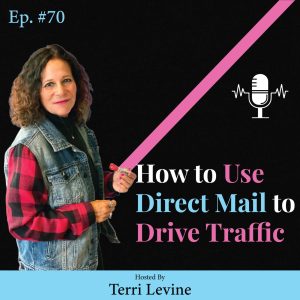As digital marketing continues to evolve, many businesses face challenges in reaching their target audience and driving website traffic.
Fortunately, some have found success with direct mail marketing. By targeting prospects directly, businesses can increase website traffic and improve their overall marketing efforts.
In the latest episode of the Digital Marketing for Coaches & Consultants podcast, Dr. Terri Levine explores the benefits of direct mail marketing compared to Google Ads, and how to determine your target market for direct mail campaigns.
She also shares essential tips for renting a mailing list and designing a postcard that will catch the recipient’s attention.
Don’t miss out on this insightful episode! Tune in to the Digital Marketing for Coaches & Consultants podcast with Dr. Terri Levine and learn how to make the most of your direct mail marketing efforts.
Key Highlights From The Episode;
[0:42] What’s your utmost goal as a marketer?
[1:13] The meaning of lead capture
[1:31] The definition of “a lead”
[3:46] Understanding your website traffic
[5:11] The Return on Investment of direct marketing
[5:46] Which businesses are best suited for direct mail marketing?
[6:42] The advantage of using direct mail compared to Google Ads
[7:49] Determining your target market for direct mail
[9:11] Identifying client demographics using InfoUSA
[10:30] Renting a mailing list
[12:50] Why you should purchase the subscriber list instead of an opt-in list
[14:31] Things to know before you rent a mailing list
[15:45] How to design a good postcard
[17:20] Terri Levine’s final words and how to connect with her
Golden Nuggets
- Your goal as a marketer is to generate a lead by building a relationship [0:42]
- You have to have constant lead flow in your business in order to be successful [1:03]
- If you are in any industry where most people aren’t marketing, and you create a systematized schedule where you are doing direct mails regularly, you can out-market and out-compete everybody else in your industry. [7:29]
- Don’t neglect the people who are already buying your product and services while you are potentially testing a new audience [10:22]
- Each time we send direct mail to our prospects, our goal is to help them trust us. They might not know about you or your business, so you should send them something that excites them. [17:27]
Let me help you grow your coaching business:
Grab this free training and see my revolutionary process in action! Join me and my Inner Circle Students for a behind-the-scenes Live Group Coaching Call: www.6figsin6months.com
If you want to join me in one of our connect and collaborate sessions. Go to https://calendly.com/heartrepreneur/mcm-live-connect-and-collaborate-session, and select a date & time!
Oh yeah, feel free to join our free Facebook community here: https://www.facebook.com/groups/1024921757544017
Watch The Episode On Youtube:
Want More!?
Listen to the podcast version of this content on your favorite podcast platform: Apple Podcasts | Spotify | Stitcher | Google Podcasts
Watch all the episodes and more to gain more insight on Youtube: https://www.youtube.com/@coachterri/videos.
Please connect with me on social:
Instagram: https://www.instagram.com/mentorterri
Facebook: https://www.facebook.com/HeartrepreneurTerriLevine
LinkedIn: https://www.linkedin.com/in/terrilevine/
Full Transcript:
Hi, there. Welcome back to The Modern Coaching Method Podcast. I am your host, Dr. Terri Levine. And today, if you’re the owner of a business, I want to talk to you about the “doingness” of your business. So, let’s just say you’re a coach — and so, you’re doing coaching, you’re a consultant, you’re doing consulting — you also have another job, and that job is to be a marketer. You need to be the marketer of your business. So first, I want to simplify marketing for you just a little bit because it’s getting more and more complicated every year with the added new digital things that are out there.
I want to keep it really, really simple today. Your goal as a marketer, your very first and foremost goal is to generate a lead by building a relationship. I’ll say that, again, by generating a lead by building a relationship. It doesn’t matter what form of marketing you’re using, online or offline, the goal is to start to find people who are interested. And you have to have constant lead flow in your business in order to be successful. And we do that by what we call lead capture. And lead capture, as you probably know, is getting the name and some form of contact information from people who are your potential target audience so that you can build that relationship, and potentially, gain a new client family member.
Now, I get asked all the time to define a lead. A lead is anyone who sees whatever it is that you’re marketing. It could be an ad, it could be a billboard, it could be an online ad, it could be a banner, it could be a postcard, it could be a podcast ad, it could be email. The goal is that anyone who sees it, anyone who hears it has some kind of an interest if they’re your exact target audience. Just think about this; you can’t really control if someone goes to your website and doesn’t put in any info and your lead capture form. Or, you can’t control whether or not they go to your websites, see your phone number, and they don’t call. You can’t control whether or not they click on your email and go to your link. You can’t control whether or not they purchase.
So today, in this podcast, I want to help you by putting the control back in your hands. I have been on the internet in this industry for decades, and it has changed so much over the years. When I first started my business, I think, back on my website, it was an online brochure, basically. And today, we’re really asking how do we use a website as an opt-in to really capture our audience. We want them to fill out our form, to give us their contact information. And I want to talk to you just a little about websites today. Back in the day, my day, you threw up a website and you figured people were just going to arrive, right? We know that’s not the case.
And today, it’s really not the case. You have to find a way to drive people to your website. So please, if you put up a website, and some of you spend a lot of money on websites, which I do not advocate, don’t assume people are going to just go there. I’m going to talk to you today about how do you get people to your website using direct mail. And don’t get scared or think, “Oh, direct mail,” because if you’re not using direct mail, that’s a mistake. I will tell you that, if people are interested in what you’re offering, around 95% of them will go check out your website before they even contact you at all.
Most of them will go to your website before they even go online and look at your Google reviews. And some of them will check out your Google reviews first. And most people, when they go to your website, are making a first impression. They’re making an impression about you, about your business, right there on your website. And to give you a statistic, 96% of people who go to your website will leave without doing anything. So, let’s say you’re doing a marketing campaign, and you’re driving lots and lots of traffic to your website. And then, you go to your Google Analytics and you go, “Wow, our website hits, they’ve really spiked. That’s great. We’re getting so many more people to our site.”
However, 96% of them are still leaving without doing anything, and then, you’re losing those leads. And there’s absolutely nothing you can do with them. So I’m going to show you how to change that with direct mail, which will drive people to your website, and that is where everybody goes. And I’m sharing statistics with you just because I think most people in the industry don’t understand how direct mail works. Very often, people think, “Oh, that’s really old school and it doesn’t work anymore.” Well, I will tell you, if it didn’t work anymore, then the internet marketers that I know, internet marketers wouldn’t be using direct mail, right?
The reason their businesses are thriving is because they use direct mail that sends them to their internet offers. And my very best clients send out mailings every single week. So, direct marketing, like I’m talking about, yields an average of 13 to 1 return on investment. That’s an average, and that’s an average across so many different industries. And different industries will certainly have different response rates and different ROI. Not every solitary business is perfect for direct mail. So, I always tell authors, if you’re an author, and you want to sell your book, a $30 book or a $20 book, using postcards or using direct mail isn’t going to cover the cost of direct mail.
However, as long as your lowest ticket item is $500 or higher, then you’ll do plenty of business with direct mail, and you’ll be able to reach people who are interested in your product or service. So, we’re going to get to that. But I don’t want to give you any words that you might not know, and I don’t want to assume that you know some of these words, so I’m going to go through a couple. PPC is pay-per-click. So, that’s basically Google AdWords or Google ads. And you see those all the time when you go to Google, you’ll see sponsored ads. And when we talk about pay-per-click, that is having raw people who aren’t even slightly cooked, who’ve never been to your website, who know nothing about you and your business, who Google puts your ad in front of them and tries to drive them to your website.
Just think of them. They’re brand-spanking new leads. Now, if we do direct mail, instead of Google ads, direct mail is very targeted, it gets a 900% better response rate. They say that 60% of consumers have visited a promoted website because of direct mail. 60%. 75% of consumers try a business for the first time because of direct mail. I hope you’re breathing in these statistics. So, I really want you to understand that after serving clients, and prospective client family members, and asking, “What kind of marketing are you doing?” I find that most people are doing almost no marketing.
And it’s a really interesting thing to look at because, if you are in an industry where most people aren’t marketing, and you create a systematized schedule where you’re doing direct mail on a regular basis, then you can out-market, you can out-compete everybody else in your industry, it’s not that difficult to learn how to do this. So, I want you to think about your target market for a moment. Your target market are people who are most likely to purchase your products or your services. And then, you have to think about how far of a reach will you have with direct mail.
So, I have client family members who have offices in a geographic location, they only market in that geography. Then I have client family members who are international like I am, so we market in all English-speaking countries. Then we have client family members who are more just the US, or just Canada, whatever it might be. I’ve had client family members who are in not a rural area, and they go outside their major city 20 or 30 miles. I have others that are in a rural area, and then, only niche in that rural area. So, the first thing you have to think about, you know your avatars, if you don’t go back to episodes of the Modern Coaching Method where I teach that, and then, start thinking about which area.
Is it nationwide? Is it an entire state? Can I reach people online? And really think about how you’re going to target through direct mail. It’s different. If people have to drive to load a location, you’ve got to stay within an area. If it can be online, or nationwide, or on the phone, that’s a completely different thing. So, I want you to really get familiar with that. There is a company called InfoUSA, I-N-F-O-U-S-A, and they have a service where they have all kinds of data. And you can go to them, and I could say, “I want a list of consultants in this zip code, and I want them to be X age, I want them to be in this specific consulting industry. So, you look for the biggest common denominator. Are most of your clients, I don’t know, over 40? Are most of them married? Do most of them own their own home?
Once you find out and you really understand what most of your client family members’ demographics look like, then, and only then, can you purchase a mailing list of those exact people. Now, when I’ve had people come to me and they have clients all over the spectrum, that’s not as easy. So, you have to really nail down the characteristics of your client family members. And you know what? When you’re doing direct mail, I’ve said to many of my client family members, maybe this is a good time to shift your avatar, maybe you want to really isolate the people who can better afford your product or services if you’re getting a lot of nos.
Now, I always recommend never neglect your bread-and-butter clients. Don’t neglect the people who are already buying your products and services while you potentially are testing out a new audience. You can buy so many different kinds of mailing lists. And I should say, you’re not buying them. I’m going to make that clear, you’re renting them. They give you a mailing list for a specific amount of time, and they tell you the exact number of times you can use it. So, you’re renting. It’s very unusual to find a company that will rent unlimited, most of them rent for one-time usage, or for four times, or yearly.
So, whoever you rent a list from, you always want to get the specifics. How many times can I use this list? The best thing is to buy a list that has people’s home addresses because you want to mail to people at home. And here’s the advantage; very few people are using direct mail. There’s less and less mail in people’s mailboxes, you might have noticed that yourself. Therefore, instead of email and all of these ads all over social media, and everywhere else, you can actually get people to open your mail. And, you can buy a mailing list that tells you all kinds of information. Is there a family living in the home? What’s the income of the home? Are two people in the home working? Do they have kids? What are the ages of the kids? Do they have seniors? What are the ages of the seniors?
If you’re selling b2b, business to business, then you get a list of the types of businesses that would buy from you. If you’re selling to a business, typically doing sales nowadays over the phone or by internet, and you have to know, in your company, is it all over the United States, the nation, just a zip code, or your state? What’s really cool is, with direct mail lists, you can find out how many of those types of businesses are in the area that you sell. So, let’s say, I sell to chiropractors and physical therapists, and I only sell in this Philadelphia zip code, I could find out all that info. I could find out their revenue, I can find out how many employees they have, I can find out their SIC code.
If you don’t know what that is, every business is classified this way. It’s called standard industry classification. Every business has a code that classifies it. So, I can find out their SIC codes and I can say to a mailing house, “I need these SIC codes,” which, in this case, would have been chiropractors and physical therapists. I recommend that you do not purchase opt-in lists. An opt-in is — we probably have done this — you’ve gone on the internet, you opted into someone’s form. Those are not very good lists, they usually fail. However, I will tell you what’s a good list; subscriber lists. People who subscribe to a particular publication have a real interest in that.
So, there’s a magazine that I read, it’s a yoga magazine. So, if my audience were yoga practitioners, I could see all the subscribers. If your audience purchases boats, there’s boating magazines, and there’s different mailing lists that go with magazines. I always say to my client family members when they’re choosing a niche, “If there is not a magazine for that audience, there’s probably not enough people in the audience.” Just a few other pointers. You can certainly saturate an entire area. It’s much less expensive on postage because the postal carrier, let’s just say, I did everyone who lives in my zip code – 19454, the postal carrier just goes mailbox to mailbox and puts the mail in there, and the mail isn’t separated out.
So, an entire area, it’s called an occupant list or a resident occupant list, RESOC, R-E-S-O-C. That’s great. Like, if you’re a local restaurant or you’re a local dentist, you can get hit every single household. However, if I’m not a dentist, I’m an orthodontist, I’m a specialist, I don’t want to hit every household. I only want to hit the households of families with children — I’m not an orthodontist, but I’m guessing between like 7 and 13, or something like that. So, I’m recommending you do this strategy. Make sure that you ask qualifying questions of the companies that you rent lists from, I have good companies if you want to know who they are. And you also want to find out how often they update the list because the answer that you need to hear is ‘continuously.’
Now, some people don’t do their lists continuously, you’ll get a lot of bad addresses. If somebody just moved today, you buy the list tomorrow, you’re probably not going to have their new address. However, I only work with mailing houses that have a guarantee of 90%. 90% deliverability. And that they refund me the cost of each bad address. So, if I get bouncebacks, I’m refunded for that. So, the last couple of points. Continuously market to the same people. One of my client family members started sending out postcards. And she sent to one list, and she didn’t understand that the next month she was to send another mailing to the same people, she sent to another list. No, we’ve got to touch people 11 to 13 times so that they get to know us, like us, and trust us.
Think about your direct mail. I like postcards. The person looking at that postcard, they want to see instantly, “What product or service does this solve for me?” Do I have a toothache? Do I need a dentist? That’s a problem, I need it solved. I remember when I was younger, I kept getting postcards from people who were talking about IRAs, and I was in my early 20s not making a lot of money. I didn’t even know what an IRA was. Now, later in life, when companies sent me those kinds of postcards, I would have paid more attention when I understood and was interested in investments. So, make sure you don’t use any terminology that they will not understand. And the whole goal of the postcard is to attract their attention.
If you haven’t read my book; The Conversion Equation, go to Amazon, I really mean this, and get a copy because I teach you how to design these, and how to use headlines and subheads. And we’ve got to look at everything in a mailing; the aesthetics, the font, the colors, the mood. We’ve got to attract them. We have to use a compelling headline and subhead. We’ve got to get their eye to keep reading, keep reading, keep reading. We have to have elements and colors that call out to them so they don’t throw it in the garbage. We have to have, not only a bold headline, we have to have a really clear call to action. We have to have images. So, there’s a lot to putting together a postcard, and you could either do it right or you could do it wrong, and I want to help you do it right.
So, if you haven’t joined our Facebook group; Heartrepreneurs with Terri Levine, go in there, I teach this quite a bit. Just remember this; we are really trying to gain the attention of the person who’s looking at this. And each time we send them direct mail, our goal is to have them trust us even more. The person might not know about you or your business, so you want to send them something that gets them excited. Don’t be telling them the features of how things work. Tell them about the benefits, the ‘what’s in it for them,’ WIIFM, the channel they’re tuned to. What is the benefit? I’m reading your postcard, what is the benefit?
And,’family-owned,’ or, ‘quality service,’ or, ‘been around a million years,’ that might not be as important as ‘you can come in for a free appointment’ or, ‘free dental check,’ or, ‘free guarantee,’ or, ‘free shoulder massage.’ People, in my experience, they prefer money off. It’s really interesting. We’ve done a 50% off on a couple of things over the years, and we had super high conversion rate. One of them, 170%. We did 15% off, and we got less than 72%. People are looking for good deals, and then, you just highlight the ‘what’s in it for them.’ Make those prospects an offer they simply cannot refuse. And once you start doing this marketing to prospects — and also, I would recommend quarterly you send out to your own client family members and you give them value in direct mail — this could make all the difference. Don’t forget to join the Facebook group. Interact with me there, I’m truly here to help you. Bye for now.





